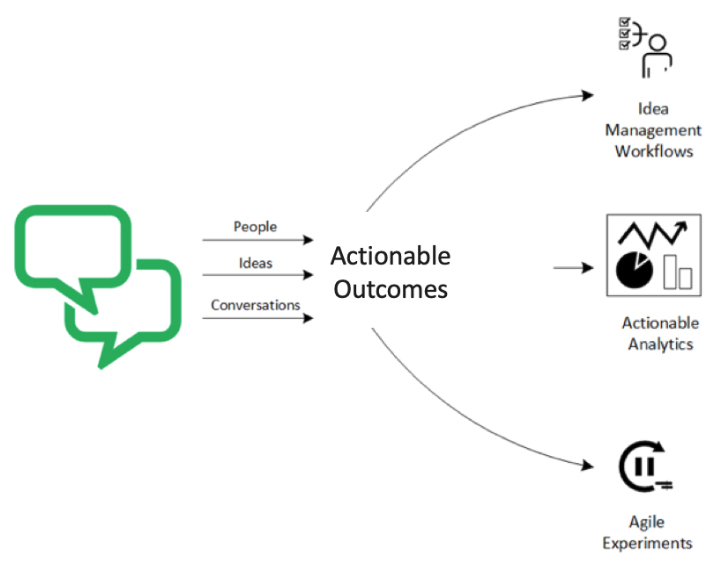
Written by Ludwig Melik, Planbox CEO
There is a lot of buzz around facilitating how people in organizations communicate and get work done. The nature of work continues to change from general collaboration to building ecosystems and enabling teamwork with external members. In its simplest form, collaboration takes place by connecting hundreds if not thousands of people and allowing them to connect and exchange views.
Now with employees, stakeholders, clients, partners, suppliers, the start-up community, researchers, universities and the public at large, the circle of contributors and level of influence they exert in your collaboration process is a moving target. Somewhere along the way connecting and facilitating this communication has taken precedence over how best to identify the real problems to focus on, find and develop creative solutions, and get actual work done. Collaboration has given way to noise that distracts from focusing on executing your business strategy.
Collaboration must have purpose
Discussing and sharing different topics is the most basic human desire to help build relationships, solve problems and find better solutions to difficult challenges if the conversation has purpose. Without purpose, chats and discussions can quickly turn something good that has the potential to be great into a distraction and wasted precious time.
For example, a great conversation takes places online by the service team about clients. Lots of threads follow and there are a number of comments made that make sense but eventually, no one really understands what was really achieved. The question then becomes, what was this conversation about? Expectedly the number of people reading and contributing starts to decline, the feedback starts to turn negative and complaints about inaction arise.
Contrast that with the same team being asked to work together to deliver a better customer experience that improves client satisfaction. Because there is a clear purpose the participation, engagement, results, and sustainability are radically different.
Collaboration must have focus
Discussions and collaborations start off with a lot of positive energy. The participants get excited at the prospect of connecting and working together. Eventually, though that activity seems a lot less rewarding if it is not clear whether the conversation is focused on a specific topic or business area.
Using the same previously mentioned example, contrast the general customer conversations with the same team being asked to work together to deliver a better experience on how customers take delivery of the solution. Because there is a clear focus the participation, engagement and actionable outcomes of this collaboration are radically different.
Collaboration must have structure
Diversity of thought and unstructured communication is important to surface important issues and identify any major concerns. Unstructured collaboration is highly beneficial in its capacity to engage a large number of users and collect a lot of information in a brainstorming campaign. However, how that information is analyzed and actioned on is what will lead to real change and positive outcomes that create business momentum.
For example, a great conversation takes places online by the service organization about clients. Lots of threads follow and there are a number of comments made but eventually, no really knows who is responsible to act, what are the assignments and how to plan out it out. The question then becomes what is next to make sure the right actions follow? Surely enough, the number of people reading and contributing starts to decline, the feedback starts to turn negative and complaints about inaction arise.
Contrast that with the same team being asked to work together to deliver a better experience with a clearly communicated process that starts with a collaboration period, followed by SMEs who evaluate and predefined metrics to help prioritize the best ideas. Because there is a clear structure the participation, engagement, results, and sustainability are radically different.
The Collaboration Continuum
Here are some practical steps to follow to achieve better business outcomes from your collaborative efforts:

- Spend a lot of time upfront thinking about the problem areas you want to collaborate on.
- Make sure any collaboration efforts are centered on focus areas that align with your corporate strategy.
- Choose the right participants from your innovation ecosystem. Contributors that you believe will want to solve the problem and develop new solutions for that specific focus area.
- Create a collaborative space that clearly defines the challenge you are experiencing, describes what you are looking for and guides participants to focus on what matters to you.
- Frame your collaboration in the context of a campaign, session or competition to help you achieve your desired outcomes.
- Time-bound your initiative. By having a clear start and end date, you can better direct your efforts, plan your activity and encourage participants by creating a sense of urgency for action.
- Gamify your collaboration by defining how participants will be rewarded and recognized for their efforts.
- Select challenge owners, moderators and idea champions who have an interest and a duty to elevate and focus the conversation that is taking place.
- Identify an executive who is interested in solving the problem at hand. This level of ownership helps create additional enthusiasm and confidence that something will ultimately get accomplished.
- Help nurture collaboration by including information from internal and external data sources that can serve as a source of supporting information, inspiration and to bring additional insights to your collaborators.
- Apply analytics to extract knowledge that leads to making real sense of what the conversation and collaboration is really saying.
- Have a plan to transition from unstructured chat to structured challenge-driven collaboration.
- Tap into subject matter experts to help evaluate your priorities around different discussion points
- Define tasks and apply a process to how you will act on the identified priorities.
- Create a continuous feedback loop that informs everyone by highlighting results and learning from failures to help nurture and sustain your purpose-driven collaboration.
Achieving Collaboration Outcomes
Without purpose, structure, and focus, we will just end up where we were 20 years ago. Capturing collaborative information and textual data is useful as long as you connect the dots. The collaboration continuum and leveraging cognitive analytics takes the early success of unstructured collaboration towards purposeful, challenge-driven, and structured conversations that lead to positive and measurable business outcomes.
